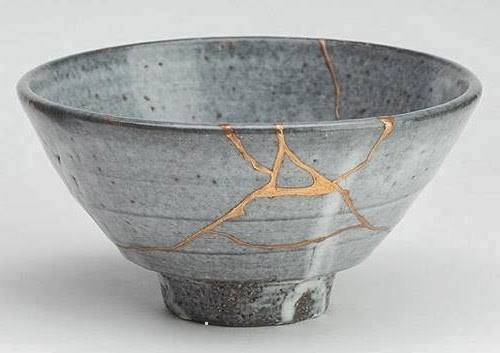
A Story
When the Japanese repair broken objects, they enhance the damaged area by filling the cracks with gold. They believe that when something has suffered damage and has a history, it becomes more beautiful.
The traditional Japanese art of repairing broken pottery with a strong adhesive, then sprinkled with gold dust, is called Kintsugi.
The result is that the pottery is not only repaired but even stronger than the original. Instead of trying to hide the flaws and cracks, they are accentuated and celebrated, as they have now become the strongest part of the piece.
Kintsukuroi is the Japanese term for the art of repairing with gold or silver lacquer, understanding that the object is more beautiful for having been broken.
Let’s bring this image to the human realm, to the world of contact with the people we love and who, at times, we hurt or who hurt us.
How important it is to make amends!
How important it is, too, to understand that damaged bonds and our battered hearts can be mended with the golden threads of love, and become stronger. The idea is that when something valuable breaks, a great strategy to follow is not to hide its fragility or imperfection, but to repair it with something that stands in for gold: strength, service, virtue…
The test of imperfection and fragility, but also of resilience—the ability to recover—are worthy of being held high.
Resilience and Resources
Resilience is the ability to face adversity and emerge stronger. It can be described as the ability to recover from adversity, from crisis. It is a word that comes from physics and describes the property of matter to return to its original shape or position after being deformed. It is a quality of elasticity, tonicity, flexibility, motility.
The most resilient people, as neuroscience has shown, have greater emotional balance in stressful situations and better withstand pressure. We could say it’s a quality of inner strength and an ability to endure difficulties.
Resilience is the conviction that an individual or team has to successfully overcome obstacles without thinking about defeat, despite the results being against them. Ultimately, it leads to exemplary behavior that stands out in situations of uncertainty, with highly positive results. (E. Machacon 2011, “Aspects Experienced,” Nov.-Dec. 2010)
This capacity for resilience is tested in situations of severe and prolonged stress, such as those due to the unexpected loss of a loved one, psychological or physical abuse, prolonged temporary illnesses, emotional abandonment, failure, natural disasters, and extreme poverty.
There is talk of children with an enormous capacity for resilience to abuse, in contrast to those who later present enormous difficulties adapting to various activities in their lives (school, establishing consistent social relationships, family environment, etc.). They may manifest excessive withdrawal or great aggression, which in any case leads them to be very vulnerable to others and to project their feelings of anger onto objects or people.
It could be said that resilience is fortitude beyond resistance. It is the ability to overcome an adverse stimulus. Being resilient is not about being extraordinary: this capacity is present in every person. The task is to develop this capacity with attitude and firmness, and it will depend on the resources we have and develop.
In a conflictual situation, we must ask ourselves the following:
Do we have resources available at that moment?
Can we activate and mobilize those resources?
As therapists, we must help the client become aware of the resources they have and how to mobilize them. And my experience in counseling is that we all have resources, even if we don’t use them.
More:
- Sessions in Barcelona and Reus: https://www.craneosacral-panizo.com/tratamientos/
- Emotional Release Training Course: https://www.craneosacral-panizo.com/metodo-somatico-de-liberacion-emocional/

